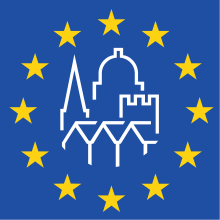European Heritage Days
The European Heritage Days were founded on the initiative of the Council of Europe. The aim of these days is to sensitize the public to the importance of cultural heritage and to arouse interest in the preservation of monuments . For this purpose, previously little-known monuments across Europe are made accessible to the public and special tours are offered. The coordination at the European level is carried out on behalf of the Council of Europe by the "Fondation Roi Baudouin" in Brussels.
In order to be able to appear as uniform as possible, there is a basic publication by Michel Kneubühler, which also presents the story, idea and principles.
history
Under the slogan “Faire passer sur le patrimoine le souffle de la vie - Breathe new life into the cultural heritage” , Jack Lang, as French minister of culture , initiated the “Journées Portes ouvertes monuments historiques” in France for the first time in 1984 . This was intended as an experiment, but was so well received that this initiative was formulated and signed as a treaty a year later in October 1985 during the Council of Europe conference in Granada on the protection of Europe's architectural heritage. The aim of the resolution was to convey the value of the architectural heritage to the public. In 1992 the Council of Europe set up its own information and communication office.
Since the entry of the European Union in 1999 - this year 46 countries have already participated - this European event has been officially titled European Heritage Days (EHD) / Journées européennes du Patrimoine .
Since then, numerous events have been taking place throughout September in the individual countries, each of different lengths and with different topics, which have the common principle of raising awareness of the richness and diversity of the common heritage in the overarching international cultural dialogue and at the same time also the to focus on numerous national and regional specialties and specialties.
Common principles
The events should follow the same principles in all countries. These are:
- The European Heritage Days take place on a weekend in September;
- Access to buildings that are otherwise inaccessible to the public is preferred;
- In the case of buildings that can normally be visited, special activities, such as special tours, exhibitions, concerts or shows, should set the day apart from the usual program;
- Visiting the monuments should be cheap, if possible free;
- Family-friendly campaigns are intended to encourage visits by young people and school-age children;
- The term European Heritage Days is to be used and advertised throughout Europe by the organizations;
- The associated logo should also be used in advertising.
EHD in the individual countries
-
 Germany - Open Monument Day
Germany - Open Monument Day
-
 France - Journées Européennes du Patrimoine
France - Journées Européennes du Patrimoine
-
 Netherlands - Open Monument Day
Netherlands - Open Monument Day
-
 Austria - Monument Day
Austria - Monument Day
-
 Scotland - Doors Open Days
Scotland - Doors Open Days
-
 Switzerland - European Heritage Days
Switzerland - European Heritage Days
-
 Slovakia - Dni európskeho kultúrneho dedičstva
Slovakia - Dni európskeho kultúrneho dedičstva
-
 Czech Republic - Dny evropského dědictví
Czech Republic - Dny evropského dědictví
-
 Hungary - (Days of Cultural Heritage in Hungary open monuments far and wide)
Hungary - (Days of Cultural Heritage in Hungary open monuments far and wide)
-
 Latvia - Eiropas kultūras mantojuma dienas
Latvia - Eiropas kultūras mantojuma dienas
Web links
- official website
- Council of Europe website
- Events 2010 PDF file, 44 kB
- Events 2011 PDF file, constantly updated
- Monument Day in Switzerland
Individual evidence
- ↑ a b A joint action of the Council of Europe and the European Commission (PDF file; 268 kB) of March 13, 2009, accessed on September 12, 2011.
